Royal Thai Navy
| Royal Thai Navy | |
|---|---|
| กองทัพเรือไทย | |
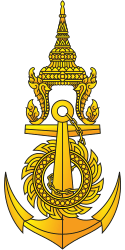 Emblem of the Royal Thai Navy | |
| Active | 8 April 1887 (131 years) |
| Country | Thailand |
| Allegiance | HM The King of Thailand |
| Type | Navy |
| Size |
71,000 Active personnel (53,000 Navy personnel) (18,000 Marine Infantry) |
| Part of | Royal Thai Armed Forces |
| Garrison/HQ |
Sattahip, Chonburi (Main base) Bangkok Noi, Bangkok (Headquarters) |
| Nickname(s) | ราชนาวี (Raj Navy) |
| Motto(s) | ร่วมเครือนาวี จักยลปฐพีไพศาล (Join the Navy to see the world) |
| Colours | Navy blue |
| March |
เพลงราชนาวี (Navy March) เพลงดอกประดู่ (Dok Pradu Song) |
| Anniversaries |
20 November 1906: Royal Thai Navy Day 4 September: Submarine Memorial Day[1] |
| Engagements |
Franco-Siamese War World War I French-Thai War (Battle of Koh Chang) World War II Korean War Palace Rebellion Manhattan Rebellion Vietnam War Piracy in the Strait of Malacca Piracy in Somalia 2015 Rohingya refugee crisis |
| Commanders | |
| Commander-in-chief | Admiral Luechai Rutdit |
| Notable commanders |
King Pin-Klao Prince of Chumphon Sangad Chaloryu |
| Insignia | |
| Flag |
 |
| Naval jack and unit colour |
 |
| Naval ensign |
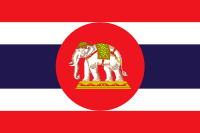 |
| Fin flash |
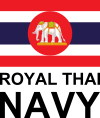 |
The Royal Thai Navy or RTN (Thai: กองทัพเรือไทย; RTGS: Kong Thap Ruea Thai) is the naval force of Thailand and part of the Royal Thai Armed Forces. It was established in the late-19th century. Similar to the organisational structure of the United States, the Royal Thai Navy includes the naval fleet and the Royal Thai Marine Corps. The Royal Thai Navy operates out of Sattahip Naval Base in Sattahip Bay. Thailand is the only Southeast Asian country that operates an aircraft carrier, though it is used as a pure helicopter carrier with the retirement of the Harrier fighter wing.[2][3] Thailand was the second Asian nation to acquire submarines, following Japan, but has had no submarines since 1950.
The United States Navy and Royal Thai Navy conduct the annual joint operation Cooperation Afloat Readiness and Training (CARAT). CARAT is an annual series of bilateral maritime training exercises of the US Navy and the armed forces of Singapore, Thailand, Malaysia, Indonesia, Brunei, and Philippines.
Budget
In fiscal year 2018 (FY2018) the navy's budget is 43,835 million baht.[4]
History
Origin
Franco-Siamese War
World War I
After World War I


French-Thai War
World War II
During World War 2, Siam allied with Japan after Japan invaded Siam in 8 December 1941.
Afterwards, the Thai navy contracted the Kawasaki Shipbuilding Corporation to build Thai ships, submarines, & coastal defense.
Vietnam War
In support of Vietnam during the Vietnam War, two Royal Thai Navy vessels undertook operations in South Vietnam.[5]
Current
The navy's combat forces included the Royal Fleet and the Royal Thai Marine Corps. The 130 vessels of the Royal Fleet included frigates equipped with surface-to-air missiles, fast attack craft armed with surface-to-surface missiles, large coastal patrol craft, coastal minelayers, coastal minesweepers, landing craft, and training ships.
The mission space of the Thailand navy includes the Thai Gulf and the Indian Ocean, which are separated by land, as well as rivers. Naval affairs were directed by the country's most senior admiral from his Bangkok headquarters. The naval commander in chief was supported by staff groups that planned and administered such activities as logistics, education and training, and various special services. The headquarters general staff functioned like those of corresponding staffs in the army and air force command structures.
RTN response to criticism
A 20 April 2014 Bangkok Post editorial said that a major news agency won the Pulitzer Prize for their work exposing Thailand's involvement in the trafficking of Myanmar's oppressed Rohingya minority through what it called a "tropical gulag". The next day, two journalists running a small, independent website in Phuket were formally indicted for criminally defaming the Royal Thai Navy by quoting part of the award-winning report. "Phuketwan editor Alan Morison and journalist Chutima Sidasathian, who had played a substantial role in the Reuters investigation, had to worry about the threat of seven years in jail and whether they would be granted bail".[6] The lawsuit was not dropped.[7] Phuketwan spent years defending itself and eventually won in 2015 but had to close down because its funds were exhausted.[8]
Command and control
The Royal Thai Navy is commanded by the Commander-in-Chief of the Royal Thai Navy, currently Admiral Na Arreenich, who was appointed in 2015. The Royal Thai Navy headquarters is in Bangkok.
- Commander-in-Chief, Royal Thai Navy: Admiral Luechai Rutdit
- Deputy Commander-in-Chief, Royal Thai Navy:
- President, Royal Thai Navy Advisory Group:
- Assistant Commander-in-Chief, Royal Thai Navy:
- Chief of Staff, Royal Thai Navy:
- Commander-in-Chief, Royal Thai Fleet:
List of commanders
Organisation
Naval Area Commands
The Royal Thai Navy operates three naval area commands:
- First Naval Area Command: responsible for the northern part of Gulf of Thailand
- Second Naval Area Command: responsible for the southern part of Gulf of Thailand
- Third Naval Area Command: responsible for the Andaman Sea (Indian Ocean)
Branches
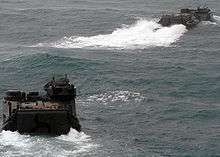
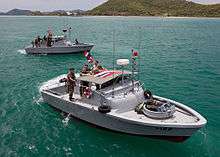
Royal Thai Naval Air and Coastal Defence Command
Coastal Defence Command was formed in 1992 under the control of the Royal Fleet Headquarters, with one coastal defence regiment (equipped with 155 mm artillery) and one air defence regiment (equipped with 40 mm and 37 mm anti-aircraft guns as well as HN-5A MANPADs). Personnel were initially drawn from the Royal Thai Marine Corps, but are now being recruited directly. The First Coastal Defence Regiment is based near the Marine Corps facility at Sattahip. The First Air Defence Regiment was near the Naval Air Wing at Utapao. Coastal Defence Command was greatly expanded in 1992, following the government's decision in 1988 to charge the RTN with the responsibility of defending the entire eastern seaboard and Southern Seaboard Development Project. The Second Air Defence Regiment, based at Songkhla, was then formed the following year. Some analysts believe that this element will eventually grow to a strength of up to 15,000 personnel.[9] They are interested in S-300 or S-400 SAMs to upgrade their air defence system.
- The First Air Defence Regiment: their mission is to provide anti-aircraft warfare for the northern Gulf of Thailand with three anti-aircraft battalions.
- The Second Air Defence Regiment: to provide Anti-aircraft warfare for the southern Gulf of Thailand and Andaman Sea with three anti-aircraft battalions.
- The First Coastal Defence Regiment has three artillery battalions.
- Two Air and Coastal Defence Command and Control Centers.
- Air and Coastal Defence Supporting Regiment: one transportation battalion, one communications battalion, one maintenance battalion.
- Equipment
- QW-18 MANPADs.
- Type 74, twin 37 mm anti-aircraft artillery
- Bofors 40L60 and 40L70 40 mm anti-aircraft artillery
- Type 59-I 130mm towed field artillery
- GHN-45 towed howitzers
- Saab ARTHUR Weapon Locating System
- KRONOS Radar Systems
District forces

- Navy Fleet District Forces
- Northern Gulf of Thailand Fleet
- Chakri Naruebet class (1)
- Angthong class (1)
- Naresuan class (2)
- Phutthayotfa Chulalok class (1)
- Ratanakosin class (2)
- Krabi class (1)
- Southern Gulf of Thailand Fleet
- Tapi class (2)
- Sattahip class (6)
- MV400 Class (3)
- Andaman Sea Fleet
- Khamronsin class (3)
- Pattani class (2)
- Northern Gulf of Thailand Fleet
- Air Force District Forces
- Navy Bases District Forces
- Sattahip Naval Base
- Bangkok Naval Base
- Phang Nga Naval Base
- Songkhla Naval Base
- Phuket Naval Base
- Samui Naval Base
- Trat Naval Base
Naval aviation
The RTN has two air wings, operating 40 fixed-wing aircraft and 30 helicopters from U-Tapao, Songkhla, and Phuket. The First Royal Thai Navy wing has four squadrons; the Second Royal Thai Navy wing has three squadrons.
Other forces
The Royal Thai Navy also consists of a Royal Thai Marine Corps division, an Air and Coastal Defence Division, Naval Special Warfare Command and a Riverine Patrol Regiment.
Naval Medical Department
The Naval Medical Department was first set up on 1 April 1890 and is currently headquartered at Somdet Phra Pinklao Hospital in Bangkok. It provides medical services for soldiers in the Royal Thai Navy and operates a number of hospitals in Thailand including Queen Sirikit Naval Hospital in Chonburi.
Rank structure
| Equivalent NATO Code | OF-10 | OF-9 | OF-8 | OF-7 | OF-6 | OF-5 | OF-4 | OF-3 | OF-2 | OF-1 | Cadet Officer | |
|---|---|---|---|---|---|---|---|---|---|---|---|---|
| Officer ranks |
.svg.png) |
.svg.png) |
.svg.png) |
.svg.png) |
.svg.png) |
.svg.png) |
.svg.png) |
.svg.png) |
.svg.png) |
.svg.png) |
.svg.png) |
|
| จอมพลเรือ | พลเรือเอก | พลเรือโท | พลเรือตรี | พลเรือจัตวา1 | นาวาเอก | นาวาโท | นาวาตรี | เรือเอก | เรือโท | เรือตรี | นักเรียนนายเรือ | |
| Admiral of the Fleet | Admiral | Vice Admiral | Rear Admiral | Commodore or Rear Admiral (lower half)1 |
Captain | Commander | Lieutenant Commander | Lieutenant | Lieutenant Junior Grade |
Sub Lieutenant | Midshipman | |
| ||||||||||||
| Equivalent NATO Code | OR-9 | OR-8 | OR-7 | OR-5 | OR-4 | OR-3 | OR-1 | |
|---|---|---|---|---|---|---|---|---|
| Enlisted ranks |
.svg.png) |
.svg.png) |
.svg.png) |
.svg.png) |
.svg.png) |
.svg.png) |
.svg.png) |
No insignia |
| พันจ่าเอกพิเศษ | พันจ่าเอก | พันจ่าโท | พันจ่าตรี | จ่าเอก | จ่าโท | จ่าตรี | พลทหาร | |
| Chief Petty Officer 1st Class |
Chief Petty Officer 1st Class |
Chief Petty Officer 2nd Class |
Chief Petty Officer 3rd Class |
Petty Officer 1st Class |
Petty Officer 2nd Class |
Petty Officer 3rd Class |
Seaman apprentice | |
Equipment
- Submarine: (1) on order + (2) planned
- Aircraft carrier: 1
- Frigates: 6+(2)
- Corvettes: 7
- Patrol vessels: 9
- Fast attack craft: 42
- Amphibious warfare ship: 3
- Landing craft, utility: 9
- River ships: 189
Fleet
| Class | Photo | Origin | Hull No./Commissioned | Displacement | Notes | |
|---|---|---|---|---|---|---|
| Aircraft carrier (1 in service) | ||||||
| Chakri Naruebet | Empresa Nacional Bazán |
HTMS Chakri Naruebet/1997 | 11,486 tonnes | Armament:
| ||
| Frigate (6 in service+(2) u/c) | ||||||
| DW 3000F class[10] | DSME |
HTMS Tachin (FFG-471) |
3,700 tonnes | Multi-role stealth frigate. (Under construction.Delivery in 2018) Armament:
| ||
Mahidol Adulyadej Naval Dockyard |
HTMS Prasae (FFG-472) | |||||
| Type 025T class | HTMS Naresuan (FFG-421)/1995 HTMS Taksin (FFG-422)/1995 |
2,985 tonnes | Guided missile frigate.
Armament:
| |||
| Type 053HT class | _-_2010.jpg) |
HTMS Chao Phraya (FFG-455)/1995 HTMS Bangpakong (FFG-456)/1995 HTMS Kraburi (FFG-457)/1995 HTMS Saiburi (FFG-458)/1995 |
1,924 tonnes | Guided missile frigate.
Armament:
| ||
| Corvettes (7 in service) | ||||||
| Ratanakosin class | .jpg) |
Tacoma Boat |
FS 441/1986 FS 442/1987 |
960 tonnes | Guided missile corvette.
Armament:
| |
| Tapi class | American Shipbuilding |
FF 431/1971 FF 432/1974 |
1,191 tonnes | Anti-submarine warfare corvette.
Armament:
| ||
| Khamronsin class | Mahidol Adulyadej Naval Dockyard and Italthai Marine |
FS 531/1992 FS 532/1992 FS 533/1992 |
630 tonnes | Anti-submarine warfare corvette.
Armament:
| ||
| Offshore Patrol vessels (9 in service) | ||||||
| River-class (OPV) | Vosper Thornycroft Bangkok Dock |
HTMS Krabi (OPV-551)/2013 HTMS Trang (OPV-552)/2018[12] |
1,969 tonnes | Armament:
| ||
| Pattani class (OPV) | HTMS Pattani (OPV-511)/2005 HTMS Naratiwat (OPV-512)/2005 |
1,460 tonnes | Armament:
| |||
| Makut Rajakumarn class | Yarrow Shipbuilders |
FF 433/1973 | 1,900 tonnes | Currently used as Offshore Patrol Vessel and/or training role.
Armament:
| ||
| M58 class | Marsun Shipbuilding |
HTMS Laemsing/2016 | 520 tonnes | This new class of Patrol Boat is expected to replace Hua hin class ships: HTMS Huahin (541), HTMS Klang (542) and HTMS Sriracha (543).[13] According to the Navy’s Strategic Plan 2008 – 2017 Royal Thai Navy will add this series with another three boat.
Armament:
| ||
| Hua Hin class | 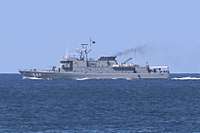 |
Asian Marine Services and Mahidol Adulyadej Naval Dockyard |
PC 541/2001 PC 542/2001 PC 543/2001 |
590 tonnes | Chinese design built in Thailand.
Armament:
| |
| Fast Attack Craft (42 in service) | ||||||
| BMB-230 Class | Cantiere Navale Breda |
FAC 321/1979 FAC 322/1979 FAC 323/1979 |
270 tonnes |
Armament:
| ||
| FPB-45 Class | ST Marine |
FAC 311/1976 FAC 312/1976 FAC 313/1977 |
263 tonnes | Similar to Singapore Navy's Seawolf-class missile gunboats (a design based on the West Germany's Lürssen TNC45 FAC[15]).
Armament:
| ||
| MV400 Class | Cantiere Navale Breda |
FAC 331/1983 FAC 332/1983 FAC 333/1983 |
450 tonnes | same as Rajcharit class except 76/62 gun in the y position replacing of SSM
Armament:
| ||
| PSMM Mk.5 Class | Italthai Marine |
PC 521/1983 PC 522/1984 PC 523/1985 PC 524/1985 PC 525/1985 PC 526/1986 |
300 tonnes | Armament:
| ||
| Tor 991 class | Mahidol Adulyadej Naval Dockyard and Marsun Shipbuilding |
T.991/2007 T.992/2007 T.993/2007 |
186 tonnes | Armament: | ||
| Tor 994 class | Mahidol Adulyadej Naval Dockyard and Marsun Shipbuilding |
T.994/2011 T.995/2011 T.996/2011 |
186 tonnes | Armament: | ||
| M36 class | Marsun Shipbuilding |
T.111/2014 T.112/2014 T.113/2014 |
150 tonnes | Armament: | ||
| M21 class | Marsun Shipbuilding |
T.228/2013 T.229/2013 T.230/2013 T.232/2016 T.233/2016 T.234/2016 T.235/2016 T.236/2016 T.237/2016 T.261/2017 T.262/2017 T.263/2017 T.264/2017 T.265/2018 T.266/2018 T.267/2018 T.268/2018 T.269/2018 |
45 tonnes | Armament:
| ||
| Training Ship/Salute Ship (1 in service) | ||||||
| Cannon class DE | Western Pipe and Steel Company |
HTMS Pin Klao/1959 | 1,620 tonnes | Former USS Hemminger (DE-746). Currently used as salute ship.
Armament:
| ||
| Amphibious warfare ship (3 in service) | ||||||
| Endurance class | ST Marine |
HTMS Angthong/2012 | 7,600 tonnes | Armament:
| ||
| Normed PS 700 class | _transits_the_Gulf_of_Thialand.jpg) |
Italthai Marine and Bangkok Dock |
LST 721/1987 LST 722/1988 |
4,520 tonnes | Armament:
| |
| Landing Craft Utility (9 in service) | ||||||
| Marsun M55 class | Marsun Shipbuilding |
LCU 784/2010 LCU 785/2010 |
550 tonnes | Armament:
| ||
| Thongkaeo class | Bangkok Dock |
LCU 771/1982 LCU 772/1983 LCU 773/1983 LCU 774/1983 |
396 tonnes | Armament: | ||
| Mannok class | .jpg) |
Silkline International - Australian Submarine Corporation (ASC) Joint Venture |
LCU 781/? LCU 782/? LCU 783/? |
550 tonnes | Armament: | |
| Replenishment ships (9 in service) | ||||||
| HTMS Similan | CSSC |
AOR 871/1996 | 22,000 tonnes | |||
| Jula class(ll) | Singmarine Shipyard |
YO 831/1980 | 1,661 tonnes | |||
| YOG-5 Class | Albina Engine and Machine Works |
YO 832/1947 | 1,235 tonnes | |||
| Prong class | Mahidol Adulyadej Naval Dockyard |
YO 833/? | 412 tonnes | |||
| Proet class | Mahidol Adulyadej Naval Dockyard |
YO 834/1969 YO 835/1970 |
410 tonnes | |||
| Matra class | Marsun Shipbuilding |
YO ???/2014 | 500 tonnes | |||
| Chuang class | _Hua_Hin_Thailand_(18155925029)_(cropped).jpg) |
Mahidol Adulyadej Naval Dockyard |
YO 841/1966 YO 842/1974 |
360 tonnes | ||
| Minesweeper ships (7 in service) | ||||||
| MSC-289 class | Dorchester Shipbuilding and Peterson Builders |
MSC 612/1965 MSC 613/1965 |
384 tonnes | |||
| HTMS Thalang | Bangkok Dock |
MCS 621/1980 | 1,095 tonnes | |||
| M48 class | Friedrich Lurssen Werft |
MCS 631/1987 MCS 632/1987 |
444 tonnes | |||
| Gaeta class | Intermarine SpA |
MCS 633/1999 MCS 634/2000 |
697 tonnes | |||
| Research and survey vessels (3 in service) | ||||||
| HTMS Chan | Friedrich Lurssen Werft |
AGOR 811/1961 | 996 tonnes | |||
| HTMS Sok | Bangkok Dock |
AGOR 812/1982 | 1,526 tonnes | |||
| HTMS Paruehasabordee | Unithai Shipbuilding and Engineering - Shelde Naval Shipbuilding Joint Venture |
AGOR 813/2008 | 1,636 tonnes | |||
| Tugboats (6 in service) | ||||||
| Rin class | Singmarine Shipyard |
YTM 853/1981 YTM 854/1981 |
421 tonnes | |||
| Samsan class | Mahidol Adulyadej Naval Dockyard |
YTM 855/1994 YTM 856/1994 |
385 tonnes | |||
| Klungbadan class | Canadian Bridge |
YTL 851/1954 YTL 852/1954 |
80 tonnes | |||
Future fleet
| Vessel | Origin | Type | Class | Displacement | Status | Notes |
|---|---|---|---|---|---|---|
| Submarine | ||||||
| Type S26T Class | Submarine | Yuan-class modified | On Surface: 2,725 tonnes Dive: 3,600 tonnes |
As of 4 Sep 2018, under construction.[16] | Delivery: c. 2023 | |
| Chalawan Class Midget submarine | Midget submarine | Chalawan (unofficial) | 150-300 tonnes | In 193 million baht design phase | Crew: 10: Range: 300 km; Cost: 1 billion baht; Delivery c. 2024[17] | |
| Frigate | ||||||
| HTMS Tachin (FFG 471) | Multi-role stealth frigate | DW 3000F class | 3,700 tonnes | Launched | Delivery in 2018 | |
| HTMS Prasae (FFG 472) | Multi-role stealth frigate | DW 3000F class | 3,700 tonnes | Order | Delivery in 202X | |
| Patrol vessel | ||||||
| HTMS Trang (OPV-552) | Offshore patrol vessel | River class | 1,900 tonnes | Order | Delivery in 2018[18] | |
Aircraft
| Aircraft | Photo | Origin | Type | Quantity | Notes |
|---|---|---|---|---|---|
| Dornier Do 228 | 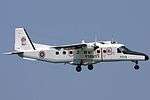 |
Maritime patrol aircraft | 7 | Also used in Royal Rain Project. | |
| Fokker F.27-200/400 | 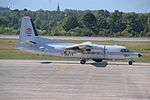 |
Military transport, Maritime Attacker, ASW | 2 Mk400 3 Mk200 |
Equipped with Harpoon. | |
| Lockheed Corporation P-3T/UP-3T | 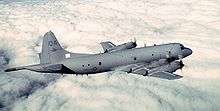 |
Maritime patrol aircraft, ASW | 3 | Version for Royal Thai Navy. | |
| Canadair CL-215 | .jpg) |
SAR, Firefighting | 2 | ||
| NAX Seaplane | Maritime patrol aircraft | 2 | |||
| GAF N.24A Normad | Military transport | 5 | Another airframe is in use for spares recovery. | ||
| Bell 212 | .jpg) |
Military transport | 6 | ||
| Bell 214ST | VIP, transport | 5 | |||
| Sikorsky S-76B | SAR, transport | 5 | |||
| Sikorsky SH-70B Seahawk | _in_the_Gulf_of_Thailand_conduct_an_in-flight_refueling_simulation_with_a_Thai_Navy_S-70B_Seahawk_helicopter_130608-N-AX577-323.jpg) |
ASW | 6 | HTMS Chakri Naruebet Flying Unit. | |
| Sikorsky MH-60S Knighthawk | 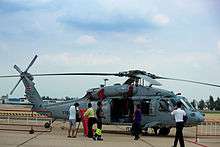 |
Military transport | 2 (+4) | HTMS Chakri Naruebet Flying Unit. | |
| AgustaWestland Super Lynx 300 |  |
Anti Ship | 2 | ||
| Airbus H145M |  |
Military transport | 5 |
Procurement plans
The Thai navy has been lobbying for submarines for years.[19] In January 2017 the Thai National Legislative Assembly tacitly approved the expenditure of 13.5 billion baht (US$383 million) to buy one Chinese S26T submarine, a derivative of China's Yuan Class Type 039A submarine.[20][21][22][23] The S26T submarines are diesel-powered with a displacement of 2,400-3,000 tonnes.[24] It is projected to be the first of a three-boat, US$1 billion acquisition.[22] The cabinet approved one submarine purchase on 18 April 2017 with a budget of 13.5 billion baht (US$393 million), including weapons systems, spare parts and technology transfer.[25] The sub is expected to be delivered in about 2023. The Thai navy's submarine squadron has trained in Germany and South Korea but has no submarines—its last sub was decommissioned in 1950. It does have a submarine headquarters: in July 2014 a US$17.3 million submarine headquarters and training center was opened at the Thai navy's largest port in Sattahip. Prime Minister Prayut Chan-o-cha has explained that Thailand will buy submarines, "not for battle, but so that others will be in awe of us."[26] Deputy Prime Minister and Defence Minister Gen Prawit Wongsuwon said that "...growing territorial threats and an increasing number of maritime missions has prompted the navy to strengthen its submarine units."[27] There are plans to base one submarine at Mahidol Adulyadej Naval Dockyard in Sattahip District, Chonburi, one at a submarine dockyard off the Sattahip coastline, and one on the Andaman coast, in either Krabi or Phang Nga.[27]
Humanitarian relief operations
Thailand worked with more than 60 nations in providing help to the Nepali people following an earthquake. Operation Sahayogi Haat ('helping hands') was a US military relief operation delivering humanitarian assistance to victims of the April and May 2015 Nepal earthquakes. The Royal Thai Navy assisted relief efforts.[28] A magnitude 7.8 earthquake struck the region of Kathmandu in Nepal on 25 April 2015. Operation Sahayogi Haat (Nepali: 'helping hands')[upper-alpha 1] for humanitarian relief operations was put into action by Joint Task Force 505 on 6 May.[32]
See also
- Admiral Prince Abhakara Kiartiwongse Prince of Chumphon
- Royal Thai Armed Forces Headquarters
- Military of Thailand
- Royal Thai Army
- Royal Thai Air Force
- Royal Thai Marine Corps
- Royal Thai Naval Academy
References
Notes
Citations
- ↑ Panrak, Patcharapol (2015-09-16). "Hoping again to become submariners, navy celebrates Submarine Day". Pattaya Mail. Retrieved 6 September 2018.
- ↑ "End of a Legend - Harrier Farewell". Archived from the original on 24 December 2014. Retrieved 24 December 2014.
- ↑ "Navy's 'toys' indefensible" (Editorial). Bangkok Post. 20 February 2017. Retrieved 21 February 2017.
- ↑ "THAILAND'S BUDGET IN BRIEF FISCAL YEAR 2018". Bureau of the Budget (Thailand) (Revised ed.). p. 84. Retrieved 6 September 2018.
- ↑ Cold War Southeast Asia. Retrieved 24 December 2014.
- ↑ "Navy must end its attack on reporters". Bangkok Post. Retrieved 24 December 2014.
- ↑ "Navy to extend lawsuit to Reuters". Bangkok Post. Retrieved 24 December 2014.
- ↑ "BBC journalist faces five years jail for Thailand reporting". Digital Journal. Agence-France Presse (AFP). 23 February 2017. Retrieved 23 February 2017.
- ↑ John Pike. "Air and Coastal Defense Command". Retrieved 24 December 2014.
- ↑ Nanuam, Wassana (21 April 2013). "S Korea to build Thai navy frigate". Bangkok Post. Retrieved 1 June 2015.
- ↑ Center, Korea Marine Equipment Global Service. "News&Event | Community | KOMEC-Korea Marine Equipment Global Service Center". www.komec.kr. Retrieved 2017-04-11.
- ↑ "Navy to build B5.5bn missile-equipped patrol vessel". Bangkok Post. 29 Feb 2016.
- ↑ "Thai Shipyard Marsun to supply M58 Patrol Gun Boat for Royal Thai Navy". November 10, 2013.
- ↑ "M58 Patrol Gun Boat". Marsun Shipbuilding. 2 July 2016.
- ↑ "Naval vessels as built by Lurssen GmbH". Lurssen.com. Archived from the original on 19 July 2011. Retrieved 3 May 2011.
- ↑ Wassana, Nanuam (2018-08-29). "Work to begin on China-sourced sub". Bangkok Post. Retrieved 3 September 2018.
- ↑ Nanuam, Wassana (18 July 2018). "PM approves 'midget' subs for navy". Bangkok Post. Retrieved 18 July 2018.
- ↑ "Thai Navy May Build Second Patrol Boat Under BAE License". Defense News. Retrieved 24 December 2014.
- ↑ Parameswaran, Prashanth (2017-01-20). "When Are China's Submarines Coming to Thailand?". The Diplomat. Retrieved 3 September 2018.
- ↑ Nanuam, Wassana (25 Apr 2017). "Submarine buy wins 'secret' nod". Bangkok Post. Retrieved 3 September 2018.
- ↑ "Royal Thai Navy announces plan to buy Chinese Yuan-class submarines". IHS Jane's 360. 3 July 2015.
- 1 2 Wassana, Nanuam (1 July 2016). "Navy submits B36bn plan to buy subs". Bangkok Post. Retrieved 2016-07-01.
- ↑ Voytenko, Mikhail (19 December 2017). "Chinese AIP submarines not the best choice". Maritime Bulletin. Retrieved 20 December 2017.
- ↑ Mark, Eugene (20 July 2016). "Does Thailand Really Need Submarines?". The Diplomat. Retrieved 23 July 2016.
- ↑ "Thailand approves $393-mln purchase of Chinese submarines". Reuters. 24 April 2017. Retrieved April 24, 2017.
- ↑ Macan-Markar, Marwaan (2 February 2017). "Thailand and China: Brothers in arms". Nikkei Asian Review. Retrieved 2 February 2017.
- 1 2 Nanuam, Wassana (7 March 2017). "Navy wants 3 dockyards for submarines". Bangkok Post. Retrieved 7 March 2017.
- ↑ Martinez, Staff Sgt. Alexander (29 May 2015). "Thai and USA forces combine to help earthquake victims in Nepal". Pattaya Mail. Retrieved 31 May 2015.
- ↑ "Nepal Earthquake Relief Effort Named 'Operation Sahayogi Haat'" (News release) (Press release). Kathmandu, Nepal: Joint Task Force 505. 10 May 2015. Retrieved 30 May 2015.
- ↑ "Operation Sahayogi Haat / Helping Hand". GlobalSecurity.org. Retrieved 31 May 2015.
- ↑ "Nepal Earthquake Relief Effort Named 'Operation Sahayogi Haat'". Nepal Foreign Affairs. 10 May 2015. Retrieved 31 May 2015.
- ↑ "Joint Task Force Activates for Nepal Earthquake Relief". Marine Corps Forces Pacific News Release. US Department of Defense. 6 May 2015. Retrieved 29 May 2015.
Sources
![]()
External links
| Wikimedia Commons has media related to Royal Thai Navy. |
- Official site (in Thai)
- Global Security – Thailand navy
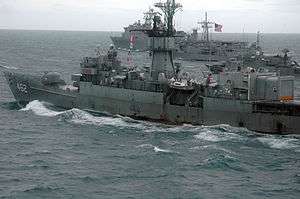
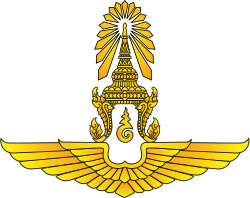

.svg.png)